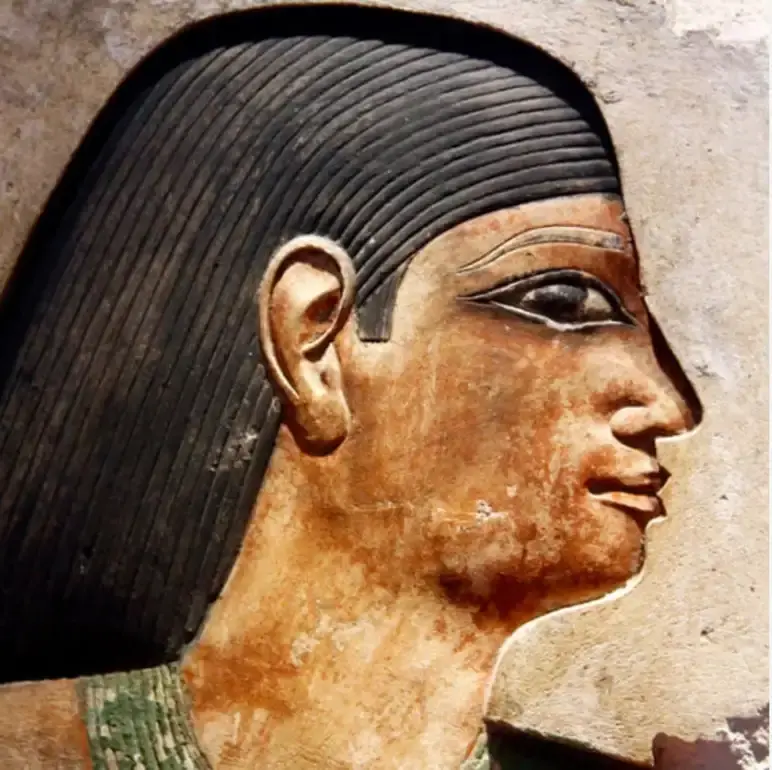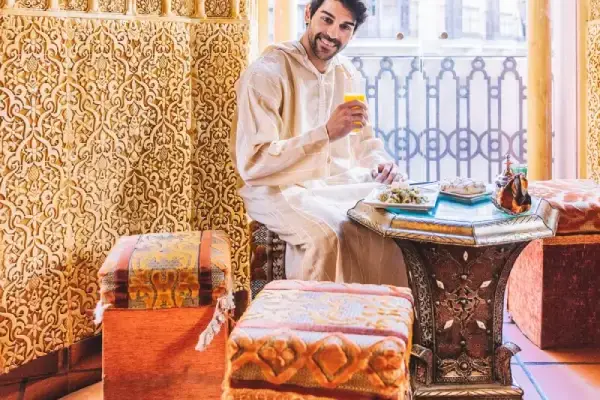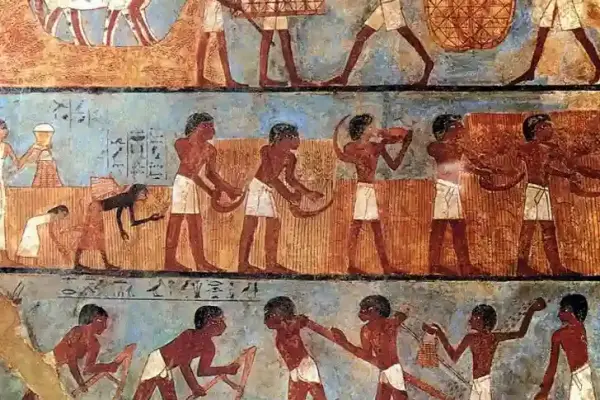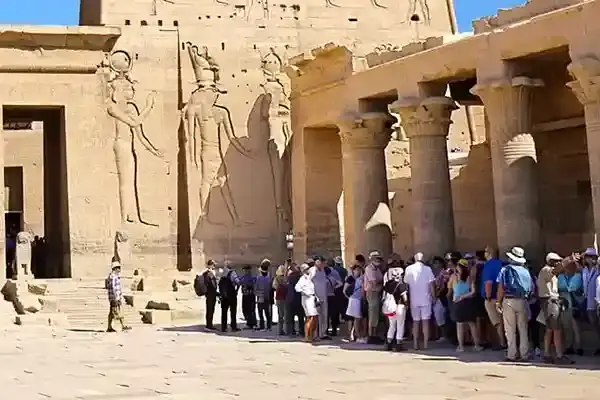Ancient Egypt’s artistic and architectural accomplishments were only possible due to the skillful craftsmen. Expertise covered many areas including making monumental statues, delicate jewelry, and household items. They had a functional but also a deeply religious and cultural role. They made temples and tombs visually spectacular, and at the same time met practical needs. In this article, we will take a deeper look into what did craftsmen do in Ancient Egypt, how they lived, what kind of materials and tools they used, and their importance in society.
Table of contents [Show]
- Social Value of Ancient Egyptian Craftsmen
- What Did Scribes and Craftsmen Do?
- What Did Craftsmen Do in Ancient Egypt?
- What Was the Main Job in Ancient Egypt?
- What Did Egyptians Look Like?
- Ancient Egyptian Craftsmen Materials
- Tools and Products
- Facts About Ancient Egyptian Craftsmen
- Daily Life of a Craftsman in Ancient Egypt
- What Did Craftsmen Do in Their Free Time in Ancient Egypt?
- Who is the God of Craftsmen in Egypt?
- Conclusion
- FAQs
Ancient Egyptian society placed craftsmen in a respected, but humble position. While not held in the same regard as priests or scribes, their societal importance was increased by the importance given to the religious value of their creations. By examining what did craftsmen do in Ancient Egypt, we can see their critical role in producing sarcophagi and other funerary goods essential for aiding the deceased’s journey to the afterlife. Additionally, Temples grandeur and monuments were in the hands of craftsmen, to ensure that the pharaoh’s legacy lived on forever.
Even though craftsmen were so critical, they were not wealthy, but despite being modest, they had stability and respect. Their wages were in the form of rations, including bread and beer, and, occasionally, meat. This gave them, essentially a relatively stable livelihood, to focus on that craft and community.
– This 8-day Cairo, Luxor, Aswan Classic Tours package is one of the best planning of Egypt tour. Find out about ancient pharaohs, sail along the Nile, and explore incredible landmarks. Book now to make your Egyptian dream come true!
What Did Scribes and Craftsmen Do?
Execution of complex projects required the collaboration of scribes and craftsmen.
Scribes
Artistic and structural plans were the work of the scribes. They used both papyrus and reed pens to draft blueprints for temples, tombs, and statues. These plans involved detailed illustrations, detailed text, and measurements (precise) to help craftsmen.
Craftsmen
In turn, craftsmen used these exact instructions to make plans into reality. For instance, scribes provided the text that would be written in hieroglyphics on temple walls, while the stone carvers would etch them.
What Did Craftsmen Do in Ancient Egypt?
In Ancient Egypt, craftsmen were makers of practical tools and sacred artifacts. Exploring what was done in Ancient Egypt showcases their contributions in several domains:
Building Temples
Most of this wonderful Egyptian life was created by craftsmen who built awe-inspiring temples for gods and pharaohs. Also, they Carved intricate reliefs and erected giant statues of gods and pharaohs.
Tombs were well prepared for the afterlife by the craftsmen. We know they painted murals of the deceased’s journey, carved ushabti figurines, and built beautifully designed coffins.
Making Everyday Items
Creating pottery and tools and clothes accessories for daily life.
Creating Ritualistic Objects
Made amulets, ceremonial tools, and offerings for religious purposes.
– Get an experience with Egypt’s iconic treasures through the Egypt Online Tour. We’ve got something that will make your trip unforgettable whether with our classic tours or luxury packages.
Read more: When Did Ancient Egypt Start and End
What Was the Main Job in Ancient Egypt?

The majority of Egyptians were farmers who survived largely on the rich lands of the Nile River and grew crops such as wheat, barley, and flax which formed the backbone of the society.
After farming, however, craftsmanship was one of the most highly respected professions. On the one hand, farmers provided food security, and on the other, craftsmen contributed to cultural and religious enrichment. In addition, craftsmen provided agricultural life by making tools, irrigation equipment, and storage vessels.
In addition, they contributed more, in developing the temples as well as tombs and making religious artifacts so that a balance can be achieved between sustenance and culture.
This balance, as seen in what did craftsmen do in Ancient Egypt, highlights their integral role in the civilization’s success.
What Did Egyptians Look Like?

Because of their geographic position at the crossroads between Africa, the Mediterranean, and the Middle East, ancient Egyptians exhibited diverse physical traits.
Depictions in Art
In Egyptian art, people typically had brown skin tones, almond-shaped eyes, and dark hair that was straight.
Clothing
Linen garments were worn by Egyptians because they were lightweight and fit into the hot Egyptian climate. Kilts were worn by men, and sheath dresses by women. The practical attire they wore made them comfortable during work. Jewelry made by skilled craftsmen was worn by wealthier individuals, as a mean of showing their status.
Cosmetics and Grooming
Personal grooming was important to both men and women and they used kohl to define their eyes and oils to protect their skin from the sun. They also wore wigs, usually dressed up for special occasions. Popular also were wigs, often elaborately fashioned for special occasions.
– With our Egypt classic tours, you will get time travel. Travel Egypt and see it all from Giza’s pyramids to Aswan’s temples. Book it Now!
Ancient Egyptian Craftsmen Materials

Examining what did craftsmen do in Ancient Egypt includes looking at the materials they used:
Stone
Abundant limestone was easy to carve, used for the sculptures, and building blocks. Granites and basalt were hard enough for the use of obelisks, statues, and sarcophagi as symbols of permanence and strength.
Tools, and small items, were commonly made of copper. Also, Egypt was rich in Gold, and it held a religious significance, which was often used for statues, jewelry, and burial masks. Later bronze was used for tools and for weapons.
Precious Stones
Jewelry was adorned with precious stones, including lapis lazuli, carnelian, and turquoise,e and were symbolical of power and protection.
Wood
Sparingly, imported cedar and ebony were used because of their scarcity. These materials were turned by craftsmen into furniture, coffins, and statues.
Organic Materials
Of these many materials, the most common were papyrus, reeds, and animal hides for writing, ropes, and shields.
Tools and Products

Investigating what did craftsmen do in Ancient Egypt highlights their advanced methods:
1- Tools:
- Stone Carving: Stone carvers used chisels, mallets, and abrasives to shape statues and reliefs.
- Jewelry Making: Incredibly intricate designs were crafted by the use of fine needles, molds, and hammers.
- Pottery Production: Wheels and kilns were used by potters to mold and fire their products.
- Woodworking: Imported wood was shaped into furniture and ceremonial items by axes, saws, and drills.
- Textile production: Needles and looms were used for textile production.
2- Products:
The products ranged from monumental statues, and delicately detailed sarcophagi, to everyday items such as pottery, jewelry, and furniture. All products had a purpose - whether it was functional, decorative, or spiritual.
Facts About Ancient Egyptian Craftsmen
Here are additional fascinating facts that shed light on the lives and work of Ancient Egyptian craftsmen:
Gender Roles:
Men were the majority of craftsmen, but women worked on producing textiles and weaving linen for clothing and ceremonial items.
Craftsmanship Hierarchy:
Workshops were run by master craftsmen who continued to train apprentices and pass down techniques and traditions.
Religious Significance:
But craftsmen thought their skills were a divine gift, and dedicated many of their works to a god such as Ptah, the patron of craftsmen.
Economic Contribution:
Craftsmen produced artifacts that were used in trade for all kinds of luxury goods from neighboring regions.
Hidden Names:
Some of the craftsmen secretly inscribed names of their own, to leave a personal mark on posterity.
Community Life:
Deir el-Medina is an example of a supportive village community in which families of craftsmen could live, work, and pray together.
– Discover the secrets of Egypt in 15-Day Classic Tours of the Wonders of Ancient Egypt and explore an unforgettable list of ancient wonders, from the Pyramids of Giza to the temples of Abu Simbel.
Maybe like: Strange Facts About The Pyramids
Daily Life of a Craftsman in Ancient Egypt
In state or temple workshops, the life of a craftsman started with organized schedules of work. Usually, they worked hard on assigned tasks, together with peers and overseers, and mid-day meals helped keep them functioning for long hours of concentrated labor.
Despite their rigorous schedules, craftsmen found balance through social bonds and shared purpose. Craftsmen lived with their families and spent evenings in modest homes within workers’ villages. Most of the time, they participated in communal activities and shared stories, maintaining social bonds.
– The 5-day Cairo to Luxor Tour Packages will allow you to discover Egypt’s treasures. Take a look at Great Pyramids, Valley of the Kings, and more on a wonderful cultural journey. We invite you to take a look at Grand Egyptian Museum Tour
Read more: What did Hatshepsut do
What Did Craftsmen Do in Their Free Time in Ancient Egypt?
Craftsmen engaged in activities that strengthened community bonds, such as attending festivals, playing board games like senet, and participating in religious ceremonies. Also, storytelling and music were popular forms of entertainment they had.
This balance between work and leisure reflects the holistic nature of life in Ancient Egypt, where craftsmanship was intertwined with cultural and social practices.
Who is the God of Craftsmen in Egypt?

Egyptian craftsmen had a patron deity named Ptah, who was the god of creation and craftsmanship and was believed to have made the universe with thought and his speech, which had inspired artisans in their work. The association of craftsmanship with Ptah raised the spiritual value of craftsmen's art, assimilating their activities to god’s workmanship.
Indeed, there was also Imhotep, the ancient physician and architect who had been worshipped as a god of wisdom, healing, and craftsmanship. He was also the patron of scribes, builders,s, and stoneworkers.
– With our Egypt Luxury Tours, you can experience Egypt in a style like never before. Go to the Pyramids, sail the Nile, and enjoy top-class accommodation for an unbelievable trip.
Maybe like: What did Greek replace Egyptian gods name with
Conclusion
A deep dive into what did craftsmen do in Ancient Egypt tells us their integral role in the cultural, religious, and architectural successes of that civilization. These were skilled artisans who were guided by tradition and divine inspiration and left an enduring legacy that continues to captivate the world with their work that not only shows their craftsmanship but is undoubtedly representative of the values and aspirations of Ancient Egypt.
FAQs
1- What did craftsmen in ancient Egypt eat?
Bread, onions and lentils, fish, and dates were often eaten by craftsmen together with beer. Meat and fruit were rare food items introduced at special events or festivals.
2- What did craftsmen wear in ancient Egypt?
Simple linen garments were suitable clothing for Egypt’s hot climate and were worn by craftsmen. Kilts were the men's dress, with sheath dresses worn by the women. Their clothing was practical for easy movement while at work.
3- What did craftsmen do for work?
In Ancient Egypt, craftsmen specialized in making tools, pottery, jewelry, furniture, as well as statues, and worked to blend artistry and functionality. They constructed temples and tombs, carved intricate designs, and made ceremonial objects used for the rituals. They also kept daily life, cultural traditions, and the spiritual practices of Egypt thriving, leaving a wonderful legacy of craftsmanship.
4- What did the slaves do in ancient Egypt?
Various tasks were supported by slaves, which included agricultural labor, construction, and supporting in labor-intensive tasks such as monumental works.
Popular Categories
Popular Posts

Top Alexandria Beaches You Must Visit 2026

What are the important holidays in Egypt?









